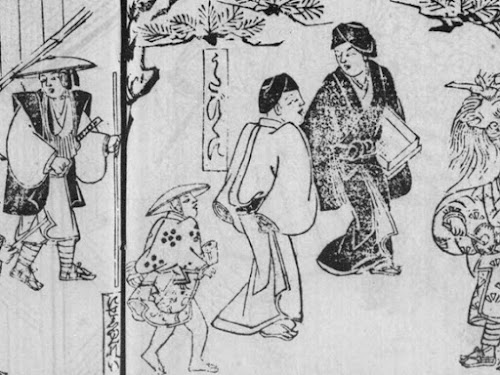Prostitute (Vol.9)、遊女(娼妓/巻の九)
Some prostitutes lived by the river near Osaka (Kanzaki) in the 11th century. They visited travelers by boat, and sang. They were called “Nakareno(floating)-kimi(girl)”. I t is written, “All people from noble men to ordinary men enjoyed.”
A girl got
a favor from the Prime Minister (M.Fujiwara). Thirty years later, another girl got
affection from his son (Y. Fujiwara) who was also the PM who built Byodouin
temple in Uji, Kyoto.
The author
wrote elegantly, although people just enjoyed while traveling. It’s
good.
Byodouin temple
『朝野群載』(1116)に、11世紀ごろの話が書かれている。
摂津の神崎などの河辺には遊女が住んでいて、「扁舟に乗て旅舶に着、枕席を薦め歌をうたふ」、公家から庶民まで「接(まじわ)らざることなし」とある。
東三条(藤原道長)が住吉・天王寺を詣で小観音を寵じた。三十年ほど後には、息子の上東門院(藤原頼通)が御幸し中君を賞したという。栄華の極みにあった貴族が遊ぶのだから、しっかりしたシステムがあったのだろう。
遊女が流れの君、ながれの身などと歌に詠まれたのは、水辺に構え舟に乗って来たからであり、「駅路のほど良きとこ処はいずくにも住いなるべし」となったという。
美しく書かれてはいるが、旅先でみんな羽根を伸ばしていたということだ。いいなあ。
In the Edo period
(1603—1868), people went to see sakura cherry blossom with prostitutes.
A short poem is written;
Hanazakari (Full bloom),
Anatade utai (some sing) konatade mai (some dance), Yujo wo tsurete (together with
party girls), Kisaragi-no-sue (at the end of February)A short poem is written;
Singing and
dancing were the art of prostitutes in the 17th century.
Many histories about prostitutes and red-light-district like Yoshiwara are written, but I am interested in the girls who were not in the mainstream.
Many histories about prostitutes and red-light-district like Yoshiwara are written, but I am interested in the girls who were not in the mainstream.
Sakura viewing party in Edo castle、千代田大奥御花見(部分)
Edo-Tokyo Museum 江戸東京博物館
時代下って、江戸時代には、花見に遊女を連れ出すようになる。
『望一千句』(1649)に「花ざかり あなたでうたひここで舞い、傾城つれてきさらぎの末」という粋な句が掲載されている。歌舞は遊女の芸だった。
遊女について様々な記述が続く。吉原の発祥は、様々な本に引用されている。
【Bathhouse girls、湯女風呂】
Bathhouses are
age-old facility; there were bathhouse girls in 1360 in Kyoto.
In the Edo period, it
says “Dozens of coquettish girls, who are called Yu(hot water)-na(girl), wash
customer's hair and body. Other beautiful and good-natured ladies serve tea and
hot water, then talk with customers. If they smile even once, it seduces men.”
Bath house、八十翁疇昔話(1837)
国会図書館デジタルコレクション、https://dl.ndl.go.jp/info:ndljp/pid/2533770
吉原などメインストリームの遊女ではなく、雑多に記載されている娼妓が面白い。
風呂屋は古くからあって女がいたという。『太平記』の延文五年(1360)の京都の記載に湯女風呂という言葉が出てきている。
江戸については、『見聞集』の引用がある。「湯女といひてなまめける女ども、廿人三十人ならびいて、垢をかき髪をそそぐ。さてまた其の外に、容色たぐひなく、心ざまゆうにやさしき女房ども、湯よ茶よといひて持ち来たり、戯れうきよがたりをなす。一度笑めばももの媚をなして男の心を迷わす」とあり、色っぽい。この記載は『江戸生活事典』の記載に似ており、原典になったのだと思う。
Although there were
bathhouse girls at every hot spring resort, there were no specially looking girls.
However, it is written “Fuji in Arima and Egawa in Ikaho were very different and
famous”. In the mid-17th century, it was prohibited to hire
prostitutes at bathhouses, but bathhouse girls remained.
Yuna girls at Arima、有馬温泉の湯女
摂津名所図会、国会図書館、https://dl.ndl.go.jp/info:ndljp/pid/2608609?tocOpened=1
湯女はどこの温泉にもいたが「称すべきほどの者はあらじ」という。ただ、有馬には藤、伊香保には江川など名の通った湯女もいたらしい(『好色徒然草』)。
明暦(1655~1658)に、風呂屋に遊女を置くことは禁じられたが、湯女はなくなりはしなかった。
明暦(1655~1658)に、風呂屋に遊女を置くことは禁じられたが、湯女はなくなりはしなかった。
【Shrine visitors and prostitutes、参詣と遊女】
There were not many
visitors to the shrine in Eitaijima, because it’s far from Edo. They hired
prostitutes and treated visitors; there were some famous girls like Orin.
It is written, “Girls serve sake(alcohol), sing, play the guitar and drum, so
let’s enjoy fad Ise-odri(dancing).”
It was said that
there was a teahouse in Fukagawa, Edo. Going out, visiting a shrine, playing at
a teahouse; I feel they were chic. Of course, I know it was a bad manner, but
visiting shrines or temples were entertainment for Japanese.
Ise-odori @ Ise、備前屋の伊勢音頭
Ise Furuichi Sangu-kaido Museum 伊勢古市参宮街道資料館
永代島に八幡社があったが江戸から遠く参詣者が少ないので、「お慈悲をもってご法度もゆるがせなれば」と、遊女を置いて参詣の輩の慰みとした。花車(かしゃ)屋のおりんなど名の通った遊女も居て、「酌とらせ、小歌うたはせ、三線を鼓に打て、後はいざ踊らむとて、当世はやる伊勢踊り云々。」(『柴の一もと』)とある。
深川八幡にも茶屋があったというが、少し出かけて、参詣し、茶屋で遊ぶ、粋な感じだ。宗教と娯楽が一体で、不謹慎といえば不謹慎だが、日本らしい。
【Bikuni (Priestess)、比丘尼】
They
asked for donations for temples, but they dressed and covered their heads
later. They sang to call for customers and prostituted. Old bikuni, who called
herself “madam”, had a Yamabushi priest husband and pupil girls. They were
popular among some men.
Uta (singer)-bikuni、うたびくに/人倫訓蒙図彙(1690)
国会図書館デジタルコレクションhttps://dl.ndl.go.jp/info:ndljp/pid/945297
尼さんに風をした遊女だという。『人倫訓蒙図彙』に「---処方に勧進しけるが、いつしか衣をりやすくし歯をみがき、頭をしさいに包みて、小唄を便りに色を売る也。巧齢へたるを御寮(おりょう)と号し、夫に山伏を持ち、女童(おんなわらべ)の弟子をあまた取てしたつる也。」とある。江戸生活事典に記載されていたが、比丘尼好き、という言葉もあったらしい。昔のポルノ映画には尼僧物があったので、マニア向けだ。
The
author read lots of books about the sex industry and wrote a lot about it. Although
there are many books about prostitutes in the old time, you can understand the
kinds and history of prostitutes only by this chapter.
The
shogunate tried to gather prostitutes in Yoshiwara red-light district, various
kinds of girls appeared one after another in the city. He also wrote a lot about gays.
However, I’m a bit unsatisfied, because he wrote based on books, not based on
his experience.
風俗業の文献を非常によく調べている。巻の九の上と下の半分を使って記載している。
遊女についての本は多いが、この章を読めば、どんな遊女商売があったのかとその由来が分かる。幕府は遊女を吉原に集めようとしたが、市中には様々な遊女が次々現れた。男色も十分紙面を割いて書いている。ただ、記載事項は、引用であって、本人が遊んだ気配がないところは物足らない。
【Codicil: Geisha girls、補足:芸者について】
Prostitutes
performed singing and dancing, but some couldn’t acquire them. Therefore, performers
who were singers and dancers appeared in the mid-18th century. They were
Gei(artistic performance)-sha(person). Afterward some of them sat down at the
shopfront as prostitutes.Geish performance in Kanazawa、Kaikaro teahouse 懐華楼
歌舞は遊女の仕事だったが、「その道心得ぬもの多くなり」、歌舞を専門に行う芸者や太鼓女郎が出てきた。宝暦(1751~1764)の頃からだという。その後、彼女らは、遊女と同じく「見せ」に並ぶこともあったという。
This is a ordinary and discreet fun. I will move on to the healthy hobby
“Insects & Plants” next.
娼妓は、日常の秘密の楽しみと言える。次も、日常の楽しみだが、健康的な虫や草木に話題を移す。
Previous
post (Gambles、勝負事・賭け):
Kiyu-Shouran
(Entertainment Encycl.) 、嬉遊笑覧 (Part 1)







Comments
Post a Comment